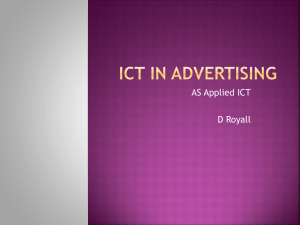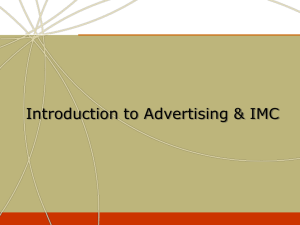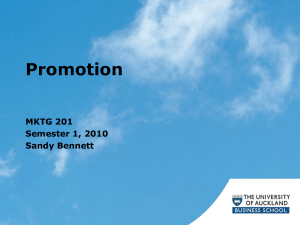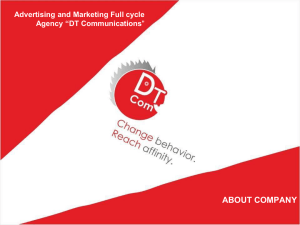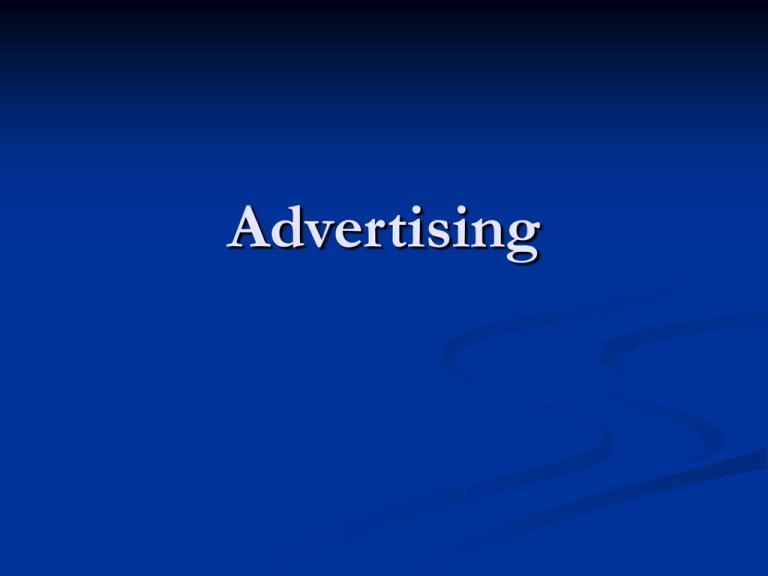
Advertising
Advertising is the nonpersonal
communication of information
usually paid for and usually
persuasive in nature about
products, services or ideas by
identified sponsors through the
various media.
Bovee/Arens, 1992
Advertising is the nonpersonal
communication of information
usually paid for and usually
persuasive in nature about
products, services or ideas by
identified sponsors through
the various media.
Two kinds of selling
Personal
Plenty of time to
deliver the message
Done
face to face
Message can be
adjusted to fit how
it’s getting across
Easy to find
customers
Expensive in both
time and money
Labor-intensive
Time
consuming
Non-Personal
Limited in time and/or
space
Don’t know who the
customer is
Don’t know how the
customer is reacting
Can’t change the message
in mid-stream
Message doesn’t have to
be created on the spot
Extensive research
Far cheaper than
personal selling
Advertising is the nonpersonal
communication of information
usually paid for and usually
persuasive in nature about
products, services or ideas by
identified sponsors through
the various media.
The Senses
Smell
Touch
Taste
Sound
Sight
Advertising is the nonpersonal
communication of information
usually paid for and usually
persuasive in nature about
products, services or ideas by
identified sponsors through
the various media.
Affirmative disclosure
"Sometimes the consumer is provided not with
information he wants but only with the
information the seller wants him to have. Sellers,
for instance, are not inclined to advertise
negative aspects of their products even though
those aspects may be of primary concern to the
consumer, particularly if they involve
considerations of health or safety . . . "
Lewis A. Engman, FTC Chair
Puffery
The
legitimate exaggeration of
advertising claims to overcome natural
consumer skepticism
Advertising is the nonpersonal
communication of information
usually paid for and usually
persuasive in nature about
products, services or ideas by
identified sponsors through
the various media.
Advertising is the nonpersonal
communication of information
usually paid for and usually
persuasive in nature about
products, services or ideas by
identified sponsors through
the various media.
Advertising is the nonpersonal
communication of information
usually paid for and usually
persuasive in nature about
products, services or ideas by
identified sponsors through
the various media.
The bundle of values
Functional
value
Social value
Psychological value
Economic value
Whatever else the consumer thinks is
important
Three ways to differentiate products
Perceptible
Actual differences
Easily seen
Imperceptible
Actual differences
Can’t be seen
Induced
No actual differences
Parity products
Advertising is the nonpersonal
communication of information
usually paid for and usually
persuasive in nature about
products, services or ideas by
identified sponsors through
the various media.
Advertising is the nonpersonal
communication of information,
usually paid for and usually
persuasive in nature about
products, services or ideas by
identified sponsors through the
various media
Has been around for a
long time
We still don’t know what
the Lascoux paintings
were for
For the first few thousand
years advertising
promoted locations,
services and “want ads”.
Ad written on a Roman tomb
Weather permitting, 30 pairs of gladiators,
furnished by A. Clodius Flaccus, together with
substitutes in case any get killed too quickly, will
fight May 1st, 2nd, and 3rd at the Circus Maximus.
The fights will be followed by a big wild beast
hunt. The famous gladiator Paris will fight.
Hurrah for Paris! Hurrah for the generous
Flaccus, who is running for Duumvirate.
Under the ad was written:
Marcus wrote this sign by the light of the moon.
If you hire Marcus, he’ll work day and night to
do a good job.
Daniel Mannix, Those About to Die
Location
Handbills and fliers to promote
events or to recruit for the
military
Handbill
recruiting sailors
for
USS Constitution
1798
Ad about runaway slave - 1770
Since most products such as
shoes and clothing were one-of
and made to order you only
needed to advertise where to
order
Service
Industrial Revolution
Early 19th Century
Mass production of products
Led to three stages of marketing:
Production-oriented
Demand far outstripped supply
Could just advertise the existence of the product
and where to get it
Whatever was made was sold
Example: People wanted cars, so car companies
made whatever they wanted and the cars were
sold before they were built
Sales-oriented
Supply exceeded demand
Companies tried to convince consumers to buy
their products rather than their competitors’
Companies still made whatever they wanted,
counting on their ability to peddle their products
Example: supply of cars went up, so the
companies made whatever they wanted and
convinced people they wanted that
Marketing-oriented
Supply of products far exceeded demand
More choices than any promotion could overcome
Resistance to “hard-sell”
Companies tried to discover what products
consumers wanted before making them, then
advertise they had it
Non-American companies (e.g., VW) found out
what people wanted, then built cars that had it
(e.g., a gas gauge)
Let’s take a example
The American auto
industry
Production-oriented
Sales-oriented
Marketing-oriented
Early sales-oriented ads were basically “caveat
emptor” (let the buyer beware)
Producers said whatever they wanted and thought
they could get away with
For example, the “Health Jolting Chair”
Led to consumer and competitor anger
1938 – Federal Trade Commission given power
to regulate deceptive and unfair advertising
Advertising could no longer lie, so new
approaches were tried
40s and 50s
Era of the hard-sell
Rosser Reeves “irritation school of advertising”
Relied on brain-numbing repetition and treating the
consumer as an idiot
The USP – Unique Selling Proposition
It was jack-hammered into consumers’ skulls
A Reeves ad
60s
The positioning era
Shift to the soft-sell
Compare your
product to your
competitors’
Treat consumers as
intelligent
Appeal to emotion
more than intellect
General comments on ads
Advertising is limited in time and/or space
Breaks the rules of grammar and syntax
Ads contain two elements
Copy
illustrations
Two basic ways of presenting a
sales message
Intellectually
Usually about the product’s function
Usually copy heavy and line drawings
Emotionally
Usually not about the product’s function
Usually copy is light with high connotative content
Uses photographs or video
Advertising aims at consumers’
subconscious minds much more than
their conscious minds
It’s all about getting the consumer to
react on a basic, instinctive level, and
not think at all
It’s about “act now” on your basic
desires – think only of yourself
It’s usually selfish and anti-social
Psychological Appeals
Self-preservation
Sex
Greed
Self-esteem
Personal
enjoyment
Constructiveness
Destructiveness
Curiosity
Imitation
Altruism
Self-preservation
“Listen to me, I’ll
keep you alive”
Because humans
are so social, we
extend the appeal to
others, like family,
friends, and social
group
Sex Appeal
“Listen to me, I’ll get you laid”
Gender linked because of different goals:
For men it’s sex with ease and no complications
In other words, attract more women that want to have
sex with you
For women it’s attract more men from which to
choose
Select the best among the possible choices, and the
greater the selection, the better the choice
Sex Appeal
Male and female animals have different sexual
strategies based on the cost of sex
Males are promiscuous because the cost is very
low
A little time, a little energy, then move on
Criteria are simple – she has to be there, breathing,
and impregnable
Females are picky because the cost is so high
Lots of time, lots of energy
Must select the best possible male, not the nearest
Criteria can be complex
Non-humans are concerned with genetics
Males want, on an instinctive level, to have as
many offspring as possible to ensure genetic
success
Females, because of the cost of reproduction,
on an instinctive level want the best genes in
their male
Males compete with other males, usually
physically, to demonstrate they’re the best choice
Females select the winner because he’s shown
he’s better than the other males
For most animals, it is the female that deals with
raising offspring (a major part of the cost of
sex)
The male has no place in rearing offspring (she’ll
even drive him away)
The major exception is birds
Even there, the female will often select one male
as the father, and another male to help her raise
the chicks
Sex appeal in humans
Humans have the most complex social life on
Earth
Instinctive criteria for men are the same as for
any other male animal – she’s there
Criteria for women is far more complex:
Not just genetically, but socially:
Be a good father – help with raising children
be a good provider – have money, social connections,
etc.
Sex appeal for men
Buy the product, get
the woman
Think of all those Axe
commercials
Sex appeal for women
For most female animals,
genetic quality is the
most important
For women, it’s a good
provider
The ad shows he has
money, cares about her
as an individual, and
will stick around
It’s called “romance”
The use of sex appeal in
advertising may appear sexist.
That’s because it is – on a social
level. But sex in advertising aims
at instinct, and society is
conscious, not subconscious.
Advertising often appeals to one
gender at the social expense of
the other.
Greed
“Listen to me, I’ll
make you rich”
Human social life
requires having
resources, usually
represented by money
Instinctively, “greed is
good”
Self-esteem
Requires a social group
Requires the individual to be able to make a
comparison with other individuals in the group
Thus, requires a sense of self as a separate entity
from others
Self-esteem
Again, there’s an instinctive gender link
For men, it’s competitive
Demonstrate he’s the best male around
Self-esteem comes from a sense of superiority
For women, it’s cooperative
Make and maintain as many connections as possible
Self-esteem comes from a sense of connection
Self-esteem for men
Demonstration of
superiority
Buy the product, be
the superior man
Often shows a “loser”
beating a “winner”
because the loser buys
the product
Self-esteem for women
The product increases
the number and
quality of
connections with
others
Personal Enjoyment
“Listen to me, you’ll have
more fun”
Humans, because of
their intelligence, are
often easily bored by
routine
The ad promotes getting
out of the routine
In other words, have fun
Constructiveness
“Listen to me, I’ll help
you improve things”
A desire to build and
improve on whatever you
have
Destructiveness
“Listen to me, I’ll tell you
how to destroy things”
We all have a desire to
occasionally blow things
up
Just watch “The
Mythbusters”
There does seem to be a
gender link – men seem to
like it more than women
Curiosity
“Listen to me, I’ll answer
your questions”
We all want answers to
things – it’s a survival
characteristic
The problem is raising
that curiosity – if the
person doesn’t care
about the answer, it’s a
useless appeal
Imitation
“Listen to me, I’ll make
you just like someone
else”
Requires the person to
want to be like the
model
Almost always linked to
one or the top five
appeals
Altruism
“Listen to me, you’ll give
of yourself with no hope
or expectation of return”
Doesn’t exist as an ideal
Reciprocal altruism does
exist
I’ll do for you now, you
do for me later
Linked to top five
Tricks of the Trade
Advertising often uses logical fallacies rather
than giving logical reasons to buy the product
advertised.
You think the ad is saying one thing when it fact
it’s saying something else, or saying nothing at all
Black/White
“You want it [whatever it
is], you can only get it
from us.”
It leaves out any other
options, e.g., “love it or
leave it.”
Buzz Words
Words that seem to say
something, but what?
“Crisp”
“Natural”
“Organic”
Weasel Words
Words tossed into a sentence that changes the
meaning while leaving an impression that’s
different
Examples:
“Our [canned] corn is as good as
fresh cooked corn.”
Libby’s Vegetables
Note it doesn’t say it’s as good as fresh corn, but
as good as fresh cooked corn.
Cooked corn has had vitamins and minerals
boiled out in the cooking process.
And now you have to heat the corn again, which
takes out even more nutrients.
The weasel is “cooked”
“Our dog food contains as much
meat protein as 10 pounds of sirloin
steak.
Alpo dog food
Targets people who love their dogs
Doesn’t contain sirloin steak, only as much meat
protein as sirloin steak
That could be any kind of meat – it’s sure not
sirloin, and may not even come from a cow
Three out of four doctors
recommend the major ingredient
in Excedrin.
“Some
studies seem to suggest that
eating the major ingredient in our
cereal may have an effect on certain
kinds of cancer.”
“If . . .”
The ultimate weasel word
Begging the Question
The question contains a statement that has not
been and is never proven, basically saying that
something is simply because it is.
Example:
“Henry Miller’s filthy books should be banned.”
Contains the unsupported premise that the books
are filthy.
Dangling Comparative
There appears to be a
comparison, but
compared to what?
It relies on the consumer
filling in the blank
Complaints about advertising
It perpetuates stereotypes
Absolutely true
It has to
Makes people buy things they don’t need
Not true
Advertising can’t make anybody do anything


